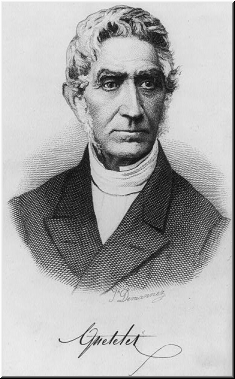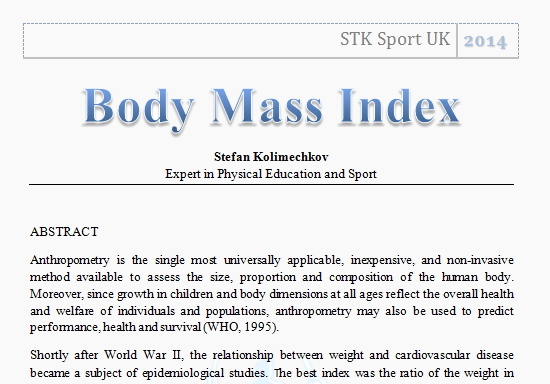Body Mass Index
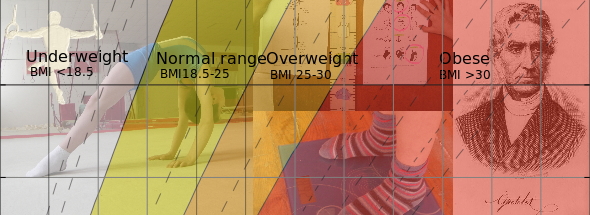
BMI
In 2020, I updated and extended this website article into a scientific review article, which was published in the Journal of Exercise Physiology and Health, so you can cite the updated version as follows:
How to cite:
Kolimechkov, S. & Petrov, L. (2020). The Body Mass Index: A Systematic Review. Journal of Exercise Physiology and Health, 3(2), 21-27.

STK SPORT
 United Kingdom, London, STK SPORT
United Kingdom, London, STK SPORT
website: www.stk-sport.co.uk
ABOUT THE WEBSITE
STK SPORT is my official website and brand.
ABOUT THIS ARTICLE
I wrote this article for my personal website, STK SPORT, in 2014. The article focuses on one of the most applied methods for assessing weight and nutritional status. Although the BMI value is calculated the same way for children and adults, the criteria used to interpret the meaning of the BMI value for children and teens are different from those used for adults. The article below explains how to calculate the BMI, how to evaluate the BMI number in different age categories, and when the BMI might be not the right method for assessing body weight. The full article is also available for download on this page. I updated and extended this article into a sceintific review in 2020, and it was published in the Journal of Exercise Physiology and Health.
Body Mass Index
Website Article

BODY MASS INDEX
Stefan Kolimechkov
Expert in Physical Education and Sport
SUMMARY
Anthropometry is the single most universally applicable, inexpensive, and non-invasive method available to assess the size, proportion and composition of the human body. Moreover, since growth in children and body dimensions at all ages reflect the overall health and welfare of individuals and populations, anthropometry may also be used to predict performance, health and survival [World Health Organization, 1995].
Shortly after World War II, the relationship between weight and cardiovascular disease became a subject of epidemiological studies. The best index was the ratio of the weight in kilograms divided by the square of the height in meters, or the Quetelet Index described in 1832 by Adolphe Quetelet (1796–1874). The Quetelet Index was termed the Body Mass Index in 1972 by Ancel Keys [Eknoyan, 2007].
Today, however, as standards of living continue to rise, weight gain and obesity are posing a growing threat to health in countries all over the world. Obesity is a chronic disease, prevalent in both developed and developing countries, and affecting children as well as adults [WHO, 2000].
ADOLPHE QUETELET
Fig.1. Adolphe Quetelet (1796–1874) |
Adolphe (Fig. 1) was born in the historic Belgian town of Gent on 22 February 1796, the fifth child of a family of nine children. He grew in politically challenging and intellectually stimulating times. An exceptionally talented student, his mathematical abilities were evident early, when he received prizes in algebra, geometry, grammar and drawing in secondary school. He was the first recipient of a doctorate in science from the University of Gent, when he was only 23 years old [Eknoyan, 2007]. In developing his index, Quetelet had no interest in obesity. His concern was defining the characteristics of ‘normal man’ and fitting the distribution around the norm. His pioneering cross-sectional studies of human growth led him to conclude that other than the spurts of growth after birth and during puberty, ‘the weight increases as the square of the height’, known as the Quetelet Index until it was termed the Body Mass Index in 1972 by Ancel Keys (1904–2004) [Eknoyan, 2007]. |
BODY MASS INDEX
The BMI is a measure of relative weight based on an individual's mass and height. Nowadays the BMI is commonly used to classify underweight, overweight and obesity. Moreover, it is adopted by the British government in an effort to promote healthy eating.
It is calculated by dividing individual’s weight in kilograms by his height in metres, then dividing the answer by his height again.
BMI (kg/m2) = Body weight (kg) / Height (m)2
For instance: BMI = 66kg / (1.69 m2) = 66 / 2.86 = 23.08
This ratio is then compared to an index chart (Fig.2), to see whether you are underweight (score of under 18.5), normal (18.5-24.9), overweight (25-29.9) or obese (over 30).
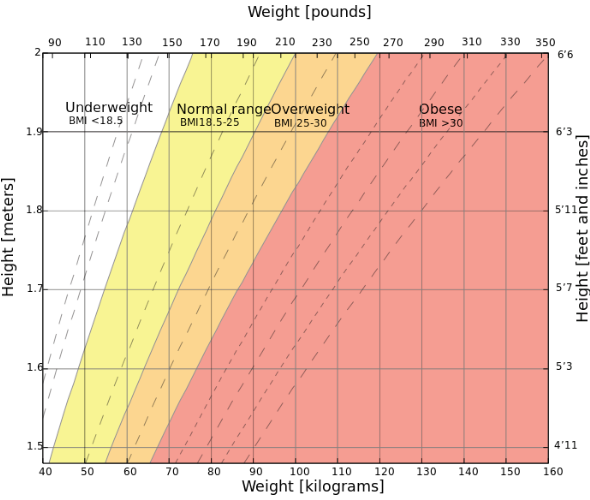
Fig.2. Body Mass Index Chart (WHO)
BMI FOR CHILDREN
Although the BMI number is calculated the same way for children and adults, the criteria used to interpret the meaning of the BMI number for children and teens are different from those used for adults. For children and teens, BMI age- and sex-specific percentiles are used for two reasons - the amount of body fat changes with age and the amount of body fat differs between girls and boys [Kuczmarski, 2000]. There are available methods for assessing the % fat based on only two skin folds (triceps and scapula), which are designed specifically for children and adolescents [Boye et al., 2002], and are commonly used in Europe and the USA [Slaughter et al., 1988].
The Centre for Disease Control and Prevention USA (CDC) BMI-for-age growth charts (Fig.3.) take into account these differences and allow translation of a BMI number into a percentile for a child's sex and age.
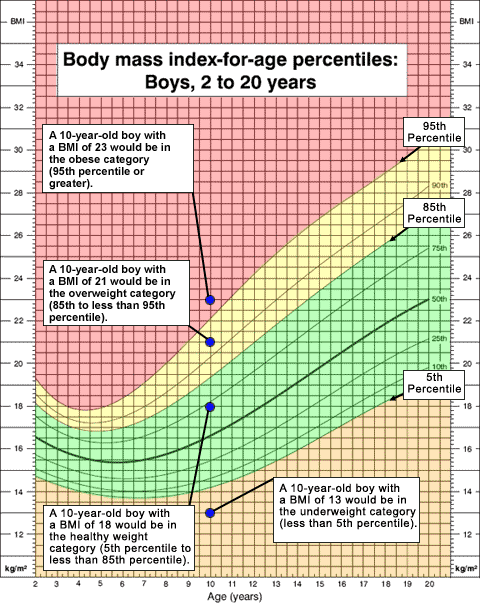
Fig.3. CDC BMI-for-age growth chart
(Centres for Disease Control and Prevention USA)
Before calculating the BMI of your child, it is vital to obtain accurate height and weight measurements (Fig.4.). Having noticed significant differences in the data concerning height and weight between our measurements and those obtained from the parents in a recent study [Kolimechkov, 2013], we recommend that weight and height in children should be measured by a coach or health professional.
STK Sport recommends that the anthropometry procedures [NHNES, 2007] should be met in order to be obtained accurate measurements [Kolimechkov, 2014].
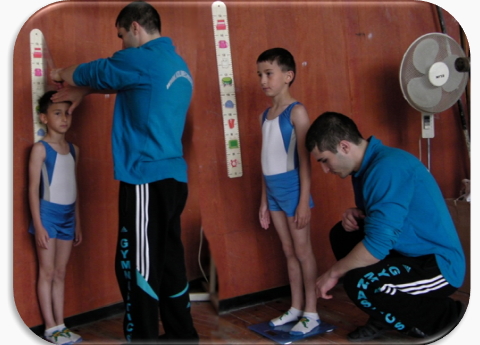
Fig.4. Assessing the physical development of young gymnasts [Kolimechkov, 2013]
STK Sport has been used specialised software prepared by the World Health Organization (WHO) – ‘WHO Anthro’ (for children under six years of age) and ‘WHO Anthro Plus’ (for children over 6 years of age), to assess height, weight and BMI in children [WHO, 2007]. For each variable we calculate the Z-score and percentile score for the relevant age. To distinguish the BMI scores, we use references provided by the WHO for children from 5 to 19 years of age (overweight > +1 SD (standard deviation), obese > +2 SD, underweight < -2SD, mortality <-3SD). The software can be found on the WHO website: (http://www.who.int/growthref/tools/en).
NHS UK provides an online application for calculating the BMI of both children and adults. To use the BMI healthy weight calculator, go to:
http://www.nhs.uk/Tools/Pages/Healthyweightcalculator.aspx
IS BMI RELIABLE?
The new term "Body Mass Index" was published for the first time in the July edition of 1972 in the Journal of Chronic Diseases by Ancel Keys, which found the BMI to be the best proxy for body fat percentage among ratios of weight and height [Keys et al., 1972] the interest in measuring body fat being due to obesity becoming a discernible issue in prosperous Western societies.
BMI was explicitly cited by Keys as being appropriate for population studies, and inappropriate for individual diagnosis. Nevertheless, due to its simplicity, it came to be widely used for individual diagnosis.
Gymnastics is considered as a sport which makes a great contribution to basic physical fitness, as well as symmetry and harmony of the body. Children, who are practising gymnastics (especially girls), have a lower percentage of fat and BMI in comparison to those who are not engaged in sports [Jemni, 2011]. In a study conducted by Benardot & Czerwinski (1991) there was shown to be a range of BMI between 12.9 and 20.8 kg/m2 for elite gymnasts aged 7-10, and from 14.6 to 20 kg/m2 for those between the ages of 11 and 14. The percentage of fat for these two categories is 5.1% - 16.7% and 6% - 15.1% respectively [Benardot and Czerwinski, 1991].
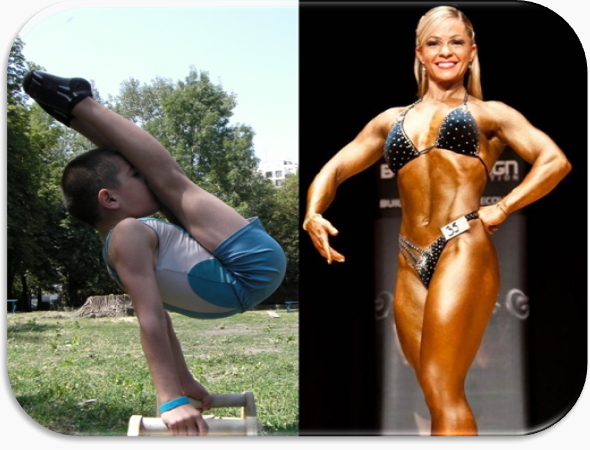
Fig.5. Gymnast D. Shaumian [Kolimechkov, 2014] and Bodybuilder Anita Albrecht
were both classified as overweight according to their BMI.
BMI Z-score of one of the best young gymnasts in Bulgaria, Vice-Champion David Shaumian, 7 years old (Fig.5. on the left), shows overweight (Z-score of BMI > 1) under the study conducted by Stefan Kolimechkov [Kolimechkov, 2013]. However, if the other anthropometric data is considered, it is obvious that his body fat percentage (11.7%) is one of the lowest in the whole group. Moreover, his upper arm muscle area content is considered as one of the highest (26.7 cm2) in the group.
Another example is the female bodybuilder Anita Albrecht who has been classified as overweight at an NHS UK centre in 2014, but the picture above appears to show the opposite (Fig.5. on the right). Albrecht is 1.5m tall and weighs 66kg which gives her the reading of 29. That is even close to obesity according to the BMI chart. Apparently BMI doesn’t distinguish between fat and muscle, so if you’re one of the few very muscly people like Anita or David, it could put you in an overweight category even if you have very little body fat.
CONCLUSION
BMI is a good indicator of variability in energy reserves in individuals with a sedentary lifestyle, but not in athletes [WHO, 1995]. BMI is not an appropriate indicator for assessing weight in athletes with great sports experience in sports which require physical strength. It is very likely that in child athletes with greater muscle mass, BMI is again not an adequate indicator [Kolimechkov, 2013]. In these cases, more anthropometric data (% fat, skin folds) should be taken, as well as strength indicators (data for muscle hypertrophy and dynamometers).
REFERENCES
Benardot D and Czerwinski C. (1991) Selected body composition and growth measures of junior elite gymnasts. Journal of the American Dietetic Association 91: 29-33.
Boye KR, Dimitriou T, Manz F, et al. (2002) Anthropometric assessment of muscularity during growth: estimating fat-free mass with 2 skinfold-thickness measurements is superior to measuring midupper arm muscle area in healthy prepubertal children. Am J Clin Nutr 76: 628-632.
Eknoyan G. (2007) Adolphe Quetelet (1796–1874)—the average man and indices of obesity. Nephrology Dialysis Transplantation 23: 47-51.
Jemni M. (2011) The Science of Gymnastics, London, UK: Routledge.
Keys A, Fidanza F, Karvonen MJ, et al. (1972) Indices of relative weight and obesity. J Chronic Dis 25: 329-343.
Kolimechkov S. (2014) STK Sport. www .stk-sport.co.uk.
Kolimechkov S, Petrov L., et all. (2013) Assessment of the physical development of pre-school and primary school children practising artistic gymnastics. Journal of Sport Science 4: 106-115.
Kuczmarski RJ. (2000) CDC Growth Charts: United States. Advance Data 314: 1-28.
NHNES. (2007) National Health and Nutrition Examination survey (NHNES). Anthropometry procedures manual, USA: CDC.
Slaughter MH, Lohman TG, Boileau RA, et al. (1988) Skinfold equations for estimation of body fatness in children and youth. Human biology 60: 709-723.
WHO. (1995) Physical status: the use and interpretation of anthropometry. Report of WHO Expert Committiee. WHO Technical Report Series 854. Geneva, World Health Organization.
WHO. (2000) Obesity: preventing and managing the global epidemic. Report of a WHO Consultation. WHO Technical Report Series 894. Geneva: World Health Organization.
WHO. (2007) BMI-for-age (5-19 years). Available at:
www.who.int/growthref/who2007_bmi_for_age/en/index.html
Full text: Body Mass Index. Website Article 2014
Author
Stefan Kolimechkov PhD
Expert in Physical Education and Sport
Academia.edu | ORCID | Research Gate | Google Scholar
Corresponding author: dr.stefan.kolimechkov@gmail.com
How to cite this article:
Kolimechkov, S. & Petrov, L. (2020). The Body Mass Index: A Systematic Review. Journal of Exercise Physiology and Health, 3(2), 21-27.
